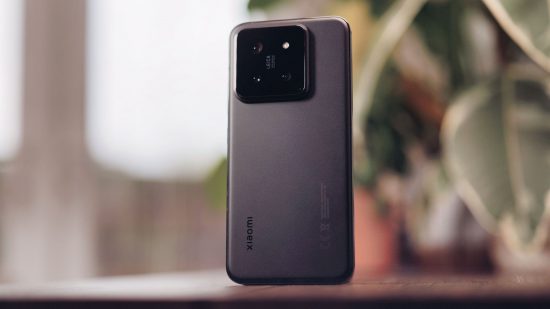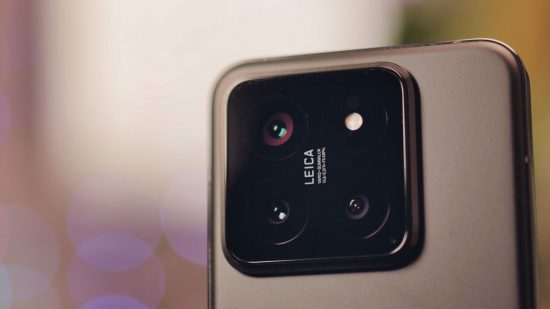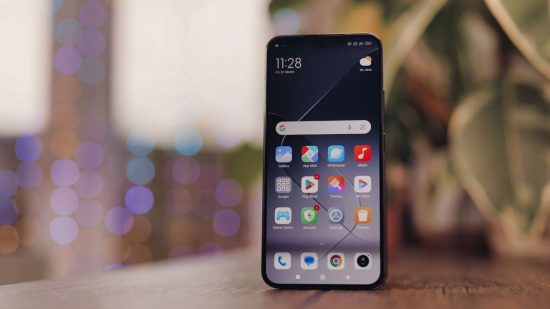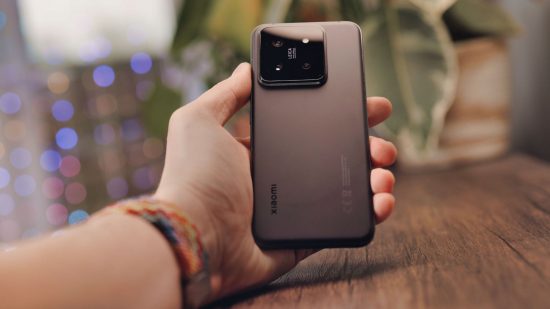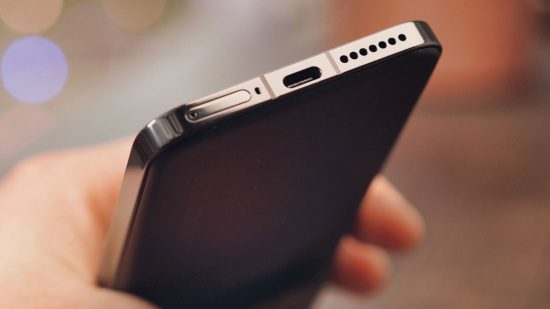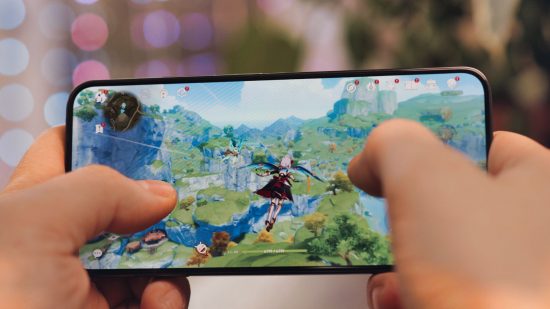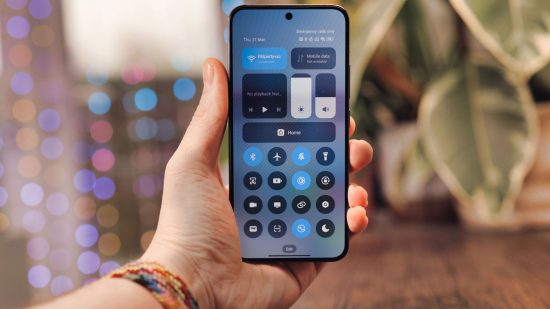Our Verdict
The Xiaomi 14 offers an uncompromising flagship experience in a slightly smaller package. Its slender chassis feels great in your pocket, and that’s before you get to grips with the top-tier performance, excellent cameras, great display, and solid battery life with speedy charging.
- Compact design
- Flagship horsepower
- Great cameras
- Speedy charging
- HyperOS takes some getting used to
- Some bloatware to contend with
- On the pricey side
If you prefer a more compact phone but still want top-tier performance, there aren’t too many options to choose between. The iPhone 15 and Samsung Galaxy S24 are the obvious choices, but the Xiaomi 14 presents a compelling alternative that just might be right for you.
It’s not exactly a small phone, but with a 6.39-inch display, it’s a lot more pocketable than bulky flagships like the S24 Ultra and iPhone 15 Pro Max. Despite the smaller dimensions, the Xiaomi 14 offers specifications that go toe-to-toe with these behemoths.
This phone offers an incredible display, tons of horsepower, great cameras, and speedy charging. However, it also comes with a pretty hefty price tag. Does the Xiaomi 14 do enough to sway users away from the more mainstream offerings on our list of the best 5G phones? I wanted to find out, and after living with it for the past few weeks, here’s everything I learned.
Why you can trust our advice ✔ At Pocket Tactics, our experts spend days testing games, phones, tech, and services. We always share honest opinions to help you buy the best. Find out how we test.
Price and availability
The Xiaomi 14 launched globally at MWC in February and is available to purchase now via Xiaomi’s website and third-party resellers like Amazon. However, as usual, Xiaomi’s global rollout doesn’t include the US, so if you want to get your hands on one in the States, your only option is importing.
In the UK and Europe, the Xiaomi 14 retails for £849 / €999 with 256GB of storage or £899 / €1099 with 512GB. This price point makes it a more expensive option than some of the competition. The Samsung Galaxy S24, for example, starts at €899, while the iPhone 15 starts at €949.
Specs
Features and software
The Xiaomi 14 runs a new version of Xiaomi’s software, HyperOS, which replaces the older MIUI skin. Android 14 is the basis for HyperOS, and while the name change makes it seem like we’re in for wholesale changes, the actual experience is very familiar.
If you’ve used a Xiaomi phone before, you won’t be in for too many surprises, as HyperOS functions almost identically to MIUI. The main differences are tweaks to the design, and I think it looks a little more polished overall. For example, the quick settings now display as symbols, with no text underneath, which looks very slick and minimal, but I did have a hard time remembering what each symbol means.
The hardest thing to get used to for Android users is the separation of the notification shade and quick settings, which you access by swiping from different sides of the display, just like an iPhone. Otherwise, HyperOS is not too dissimilar to other Android skins.
I found the system easy to live with, and it always ran smoothly with nice fluid animations. The main downside is that it comes with quite a bit of bloatware pre-installed. Most of it is Xiaomi’s own apps, but there’s also a folder full of random stuff like TikTok, Facebook, and Booking.com. It’s easy to remove, but when spending this much, you shouldn’t have to go to the trouble.
There are no fancy AI productivity features included with this phone, unless you count Google Assistant, but these features are still a rarity outside of Samsung and Google phones. You do, however, get some AI-powered image editing tools. You can erase distracting objects or people from your photos and add some pretty nice artificial bokeh effects. It’s nothing more advanced than what you can already do with Google Photos, but it’s convenient to have these abilities in the native image viewer.
Design
The Xiaomi 14 has a similar design to last year’s Xiaomi 13, and both models are quite iPhone-inspired. This build means you get flat aluminum edges, a fully flat display, and a square camera array positioned at the top-left of the rear panel.
It’s not the flashiest design, but it’s practical and feels premium. The camera housing has increased in size quite dramatically on the newer model, which hints at improvements in the photography department. It also has a new knurled ring encircling the cameras, inspired by the bezel of high-end watches. It’s a subtle trim, but it does look nice.
I have the Black model in for testing, which has a matte finish on its glass rear panel. I was happy to see this, as the older model was a fingerprint magnet, and this fares much better. The White model comes with a similar matte glass back, but the Jade Green variant has a high-gloss finish. It looks great, but you can guarantee that the green phone will be smudge-city whenever you use it without a case.
All versions have a glossy mirror-like finish on their edges, and they’re tinted to match the color of the rear panel. I’d like to see these get the matte treatment, too, as they’re very fingerprint-prone and seem like they’d scratch easily. Throughout my testing, I kept the Xiaomi 14 in the matte-black TPU case that comes in the box, alleviating these concerns.
As mentioned, it’s a smaller handset by today’s standards. It’s not tiny, though. It’s a little larger than both the S24 and the iPhone 15, but after living with the Oppo Find X7 Ultra, the Xiaomi 14 feels refreshingly compact and lightweight. Smooth corners make it comfortable to hold, and it’s much less of a bulge in your pocket.
The Xiaomi 14 has an IP68 rating for dust and water resistance, meaning it’s essentially waterproof. It’ll handle a dunking at depths of up to 1.5 meters in freshwater without damage, so it’s well-equipped to handle adventurous lifestyles.
Display
The Xiaomi 14 has a 6.39-inch display with an adaptive refresh rate that can adjust between 1Hz and 120Hz to conserve battery life and ensure everything on the screen looks buttery smooth. It has a resolution of 2,670 x 1,200 pixels, a very high pixel density for the screen size, so it always looks exceptionally sharp.
It’s a very bright display, and Xiaomi says it can output up to 3,000 nits in certain situations. In my testing, it wasn’t boosting to quite such levels, but it had no trouble competing with direct sunlight. It supports both Dolby Vision and HDR10+, and combined with this bright panel, you get some very impressive visuals from apps like Netflix and Prime Video. The blacks are dark and inky, while the highlights can get dazzlingly bright. It’s great.
As mentioned, I’m used to phones with larger displays, and I did find the Xiaomi 14 a little cramped for extended gaming sessions. I have quite large hands, though, so your mileage may vary here. Crucially, games always look fantastic on this display, so as long as you’re ok with less real estate, you’re in for a good time.
HyperOS has some of the most comprehensive display customization options I have come across, so if you like to tweak the color reproduction, you’re sure to enjoy this phone. In addition to the usual color profiles, you can switch color gamut and adjust the saturation, hue, contrast, color balance, and more.
Cameras
As the Leica branding and super-sized camera housing suggest, the camera system is a highlight of the Xiaomi 14. The brand has replaced the lower megapixel-count auxiliary lenses of the Xiaomi 13, and you now get a 50MP resolution across all three rear lenses. The main sensor is different, too, and uses a brand new sensor from OmniVision, which Xiaomi has dubbed the Light Fusion 900.
This new main sensor is quite large, at 1/1.3 inches, outscaling the main sensors of its primary competition: the S24 and iPhone 15. This increase in size means you can expect better low-light performance, with less chance of motion blur, as the large sensor pulls in more light, reducing exposure times.
It’s not just at night that this main camera shines, though. It’s the most impressive of the bunch in all conditions. Despite all three cameras offering the same resolution, the main camera captures the most detail and the sharpest images by a considerable margin. The larger sensor also means it can capture some nice natural bokeh, and close-up shots are particularly impressive.
That said, the other cameras are plenty capable, too. I really enjoyed using the 3x telephoto and found it handy for capturing portraits and close-up macro details. It begins to struggle at night, compared to the main snapper, with slightly softer details, but it’s capable of stunning images in the daylight.
The same is true of the ultrawide. It’s great in the day, with an extremely wide field of view and excellent dynamic range, but it’s less impressive at night. It also lacks autofocus, so while it’s great for capturing wide group shots and architecture, you won’t be shooting any closeups, which feels a bit limiting.
The selfie camera is a solid showing, too. It captures plenty of detail with its 32MP resolution, and Xiaomi’s image processing makes for flattering self-portraits. It’s aided by a suite of beautification effects and filters if you like to play with those, and the portrait-mode cutouts are very reliable.
In video mode, you can shoot up to 4K60 on all of the cameras and even 8K at 24fps, but that only works on the main camera and has a time limit of 6 minutes. Stabilization is good, and autofocus works well in video. There’s a surprising amount of pro controls available in the camera app, too, including full manual controls and even a LOG color profile.
Performance
The Xiaomi 14 utilizes a Qualcomm Snapdragon 8 Gen 3 SoC paired with 12GB of RAM and up to 512GB of UFS 4.0 storage. With specs like that, it’s clear that this phone is going to be ultra-quick.
In use, it does not disappoint. The system always feels snappy and responsive, apps open quickly, and it can multitask like a champ. Of course, it’s in gaming that this horsepower really shines, and the Xiaomi 14 can happily run almost any title in the Google Play Store with maxed-out settings.
As usual, I put a fair few hours into Genshin Impact, with graphics on the Highest preset at 60 fps. The Xiaomi 14 handled it with ease, and I never noticed any stutters or frame drops. The phone began to heat up a little after roughly 20 minutes, but it never got concerningly warm and remained comfortable to hold. It’s an impressive feat, given the compact chassis.
You can access the gaming menu while a game is running by swiping from the left-hand side of the display. It’s not as comprehensive as the menu that you’d find on a gaming handset, like the ROG Phone 8 or Redmagic 9 Pro, but there are more options than you’d typically find on a mainstream mobile. The gaming menu can boost performance, block notifications and calls, record gameplay footage, and even change your voice. It’s a very handy feature.
The Xiaomi 14 has stereo speakers, and the quality is pretty decent. There’s lots of clarity in the mids and highs, and there’s more bass response than you’ll find on a lot of phones. They’re not going to blow your mind, but there’s some decent stereo separation and enough volume to satisfy around the house.
Battery
The Xiaomi 14 has a 4,610 mAh battery pack, which is slightly smaller than most flagships as they trend towards 5,000 mAh capacities. With such a powerful processor on board, I was a little concerned about battery life. However, in reality, this battery capacity is more than enough for most people’s needs.
Even on days with lots of screen-on time and shooting lots of photos and videos, the Xiaomi 14 never failed to make it to the end of the day. Often, I’d go to bed with 30% or more remaining. Of course, if you’re gaming all day, you can expect the battery to drain a bit faster, but most people will comfortably get a full day’s use without recharging.
If you do need to top-up the battery during the day, it’s barely an inconvenience. It charges incredibly fast with the included 90W wall adapter. You can expect to go from fully flat to fully charged in just over half an hour, and a 50% charge will take less than 15 minutes.
The Xiaomi 14 also supports wireless charging at up to 50W, but you’ll need Xiaomi’s wireless charger if you want to hit such speeds. I had no such luck with my 50W Oppo AirVooc charger, which instead just charged at a leisurely 15W. You can also reverse wireless charge at up to 10W, and this feature could come in handy if a friend needs an emergency top-up or if your earbuds die while out and about.
Should you buy the Xiaomi 14?
If you’re seeking a slightly smaller flagship phone, the Xiaomi 14 is a brilliant option. It has top-tier performance, a great display, excellent camera performance, and solid battery life. Aside from missing out on the longer zoom lengths offered by “Ultra” flagships, there are really no compromises in choosing this more compact option.
Competition is stiff, though, and with the Samsung Galaxy S24 coming in at a lower price, a lot of people will see it as the more attractive option. That’s not to say the Xiaomi 14 doesn’t have its advantages. The Snapdragon chip is slightly better for gaming, in my experience, and the Samsung doesn’t come close to offering the same blazing-fast charging speeds. In many cases, I prefer the Xiaomi photos, too.
If you decide to go for the Xiaomi 14, you’re in for a great experience. It delivers everything I’ve come to expect from a top-of-the-line smartphone, and the fact that it does so while remaining compact and lightweight is the icing on the cake.
Alternatives
If you’re not sure that the Xiaomi 14 is right for you, here are a couple of other excellent compact flagships to look at.
Samsung Galaxy S24
The smallest phone in the S24 lineup is a great alternative to the Xiaomi 14. I’ve already mentioned that it’s a little cheaper, but it’s also smaller and goes toe-to-toe with the Xiaomi 14 in almost every area. A significant advantage of this phone is that it offers all the cool new AI features that we saw on the S24 Ultra. You’ll be waiting much longer for it to charge, though. If your budget can stretch, it’s also worth checking out our Samsung Galaxy S24 Ultra review.
iPhone 15
If you’re not married to the idea of an Android phone, the iPhone 15 is another great option. It’s also similarly compact and offers a proper flagship experience for slightly less money. The iPhone’s camera specs are a little less impressive, but it delivers good results, and the gaming performance is undeniable. If you can afford to spend a little more, our iPhone 15 Pro Max review is also worth checking out.
